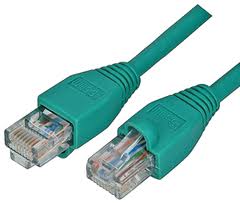Ethernet is a set of standards describing the physical requirements of networks, including cable types and cable characteristics. The standards are the responsibility of the 802.3 working group of the Institute of Electrical and Electronics Engineers, who frequently produce updated recommendations for faster networks. Each speed of network has a range of cable associated with it, and the maximum length of a cable segment depends on the Ethernet version and the cable type.
Fast Ethernet
- Although it was not the first version of Ethernet, fast Ethernet is the oldest version still in operation. It carries data at 100 megabits per second (Mbps). It uses Cat5 or Cat3 unshielded twisted pair (UTP) cable at a segment length of no more than 100 meters. UTP cable contains eight wires, grouped as four pairs. The Cat5 version of fast Ethernet is called 100BASE-T, and it uses only two of the wire pairs within the cable. The Cat3 version uses all four pairs of wires and is called 100BASE-TX. A fiber optic cable version is called 100BASE-FX. This requires two strands of fiber and the cable can stretch up to 2000 meters.
Gigabit Ethernet
- Gigabit Ethernet carries data at 1000 Mbps. It was the last version of Ethernet to use a naming convention based on the number of megabits per second it can carry. 1000BASE-T uses Cat5 or higher UTP. The cable can cover up to 75 meters with Cat5 or Cat5e or 100 meters with Cat6 UTP cable. Two Gigabit Ethernet standards using multi-mode fiber optic cable are 1000BASE-SX, using shortwave over a over a cable of up to 500 meters with a single segment of multi-mode fiber optic cable, or up to 5 kilometers with single-mode fiber optic cable.
10 Gigabit
- Ten Gigabit systems use multi-mode or single-mode fiber optic cable, UTP or twin-axial cable. 10GBASE-SR uses shortwave transceivers over a stretch of multi-mode fiber optic cable up to 300 meters in length per segment. 10GBASE-LR uses longwave transceivers over single-mode fiber optic cable in a segment up to 10 kilometers in length. 10GBASE-LX4 also covers a 300-meter stretch of multi-mode fiber or 10 kilometers of single-mode fiber. Twin-axial cable is only recommended for a stretch of up to 15 meters in the 10GBASE-CX4 standard, and 10GBASE-T uses Cat6a or Cat7 UTP cable up to a length of 100 meters per segment.
40 and 100 Gigabits
- The fastest Ethernet standards use single-mode or multi-mode fiber optic cable. A segment of multi-mode can stretch to 100 meters in the 40GBASE-SR4 and 100GBASE-SR10 standards. Single-mode fiber can carry the 40GBASE-LR4 and 100GBASE-LR10 standards up to a segment length of 10 kilometers and 100GBASE-ER10 in a segment length of up to 100 kilometers. Twin-axial cable is only recommended for stretches up to 10 meters. It is mentioned in the 40GBASE-CR4 and 100GBASE-CR10 standards.

No comments:
Post a Comment